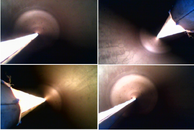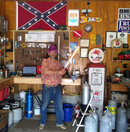Oxygen Hacker's Companion - 4th Edition
The "official" way to inspect for hydrocarbonsused to be with a UV or "black" light, since manyhydrocarbons fluoresce under UV. The only prob-lem with this is that while old-style mineral oilsmight, the contaminants that are most likely to befound in a tank or valve, synthetic compressor oiland silicone or 02-safe lube, usually don't fluo-resce! So while a blacklight may tell if if a tank isdirty, it cannot tell tell you for sure that it is cleanand should, as a result, not be relied upon.
Unfortunately, the CGA doesn't seem to beaware of this, and CGA Pamphlet G-4.1, which isthe closest thing to the official word on 02 cleaning,says that black light inspection can be done in lieu of02 cleaning, and tanks cleaned only if they fail it.THIS IS QUITE SIMPLY WRONG and potential-ly dangerous, and another reminder of how the CGA rules are often not a good match with SCUBA practice. Unfortunately, some of the dive agencies and tank inspection certification agencies defer to G- 4.1 (probably because they have never actually read . ')
Rather than take it on faith, we smeared samples
of silicone grease, Christolube Ill, some old non- synthetic compressor oil, EZIOOO synthetic com- pressor oil, SW30 motor oil and moly automobile grease on a metal sheet.
The only one to really fluoresce to the extent that it was hard to miss was the auto grease. The motor oil did fluoresce ever so slightly, so a carefull exami- nation would probably have found it, and the non- synthetic compressor oil a little less. The others did- nit fluoresce at all.





